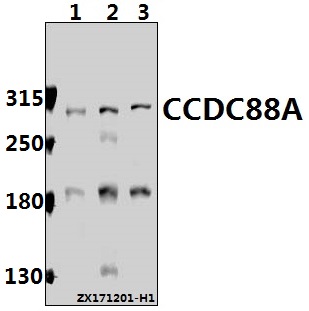Product Name :
CCDC88A polyclonal antibody Background :
The actin-binding protein girdin (CCDC88A, GIV) is a non-receptor guanine nucleotide exchange factor (GEF) and part of a scaffold that mediates key signaling pathways during cell migration. Girdin protein structure includes an amino-terminal Hook domain for microtubule interaction, a coiled-coil dimerization domain, a Gα binding domain, a PI(4)P-binding domain, and a carboxy-terminal receptor-binding domain within a GEF motif. Akt kinase phosphorylates girdin at Ser1416, which promotes PI(4)P binding, localization of girdin to the membrane leading edge, and regulation of actin organization and cell motility. After growth factor receptor activation, girdin binds both G-protein and receptor to form an activation complex at the receptor cytoplasmic tail. The activation complex enhances receptor autophosphorylation and promotes downstream signaling that results in actin organization and cell migration. An activated growth factor phosphorylates girdin at its carboxy-terminal Tyr1764 and Tyr1798 residues to form an SH2 docking site for PI3K binding. The girdin GEF motif interacts with Gα and leads to release of Gβγ, resulting in further PI3K activation and the completion of signal transduction from receptor to cytoskeleton. The cytoskeletal reorganization and cell migration properties of girdin are important in regulating several biological processes, including wound healing, angiogenesis, and cancer progression. Product :
Rabbit IgG, 1mg/ml in PBS with 0.02% sodium azide, 50% glycerol, pH7.2 Storage&Stability :
Store at 4°C short term. Aliquot and store at -20°C long term. Avoid freeze-thaw cycles. Specificity :
CCDC88A pAb detects endogenous levels of CCDC88A protein. Immunogen :
Synthetic peptide, corresponding Human CCDC88A. Conjugate :
Unconjugated Modification :
Unmodification
CCDC88A polyclonal antibody Background :
The actin-binding protein girdin (CCDC88A, GIV) is a non-receptor guanine nucleotide exchange factor (GEF) and part of a scaffold that mediates key signaling pathways during cell migration. Girdin protein structure includes an amino-terminal Hook domain for microtubule interaction, a coiled-coil dimerization domain, a Gα binding domain, a PI(4)P-binding domain, and a carboxy-terminal receptor-binding domain within a GEF motif. Akt kinase phosphorylates girdin at Ser1416, which promotes PI(4)P binding, localization of girdin to the membrane leading edge, and regulation of actin organization and cell motility. After growth factor receptor activation, girdin binds both G-protein and receptor to form an activation complex at the receptor cytoplasmic tail. The activation complex enhances receptor autophosphorylation and promotes downstream signaling that results in actin organization and cell migration. An activated growth factor phosphorylates girdin at its carboxy-terminal Tyr1764 and Tyr1798 residues to form an SH2 docking site for PI3K binding. The girdin GEF motif interacts with Gα and leads to release of Gβγ, resulting in further PI3K activation and the completion of signal transduction from receptor to cytoskeleton. The cytoskeletal reorganization and cell migration properties of girdin are important in regulating several biological processes, including wound healing, angiogenesis, and cancer progression. Product :
Rabbit IgG, 1mg/ml in PBS with 0.02% sodium azide, 50% glycerol, pH7.2 Storage&Stability :
Store at 4°C short term. Aliquot and store at -20°C long term. Avoid freeze-thaw cycles. Specificity :
CCDC88A pAb detects endogenous levels of CCDC88A protein. Immunogen :
Synthetic peptide, corresponding Human CCDC88A. Conjugate :
Unconjugated Modification :
Unmodification
-
 Western blot (WB) analysis of CCDC88A pAb at 1:500 dilution Lane1:K562 whole cell lysate(40ug) Lane2:CT26 whole cell lysate(40ug) Lane3:The Testis tissue lysate of Rat(40ug)
Western blot (WB) analysis of CCDC88A pAb at 1:500 dilution Lane1:K562 whole cell lysate(40ug) Lane2:CT26 whole cell lysate(40ug) Lane3:The Testis tissue lysate of Rat(40ug)
Bioworld Biotech only provide peptides for our antibodies and do not provide additional peptide customization services.
Price/Size :
USD 368/1mg/vial
Tips:
For phospho antibody, we provide phospho peptide(0.5mg) and non-phospho peptide(0.5mg).Describe :
Blocking peptides are peptides that bind specifically to the target antibody and block antibody binding. These peptide usually contains the epitope recognized by the antibody. Antibodies bound to the blocking peptide no longer bind to the epitope on the target protein. This mechanism is useful when non-specific binding is an issue, for example, in Western blotting (WB) and Immunohistochemistry (IHC). By comparing the staining from the blocked antibody versus the antibody alone, one can see which staining is specific; Specific binding will be absent from the western blot or IHC performed with the neutralized antibody.Formula:
Synthetic peptide was lyophilized with 100% acetonitrile and is supplied as a powder. Reconstitute with 0.1 ml DI water for a final concentration of 10 mg/ml.The purity is >90%,tested by HPLC and MS.
Storage:
The freeze-dried powder is more stable. For short time at 2-8°C. For long term storage store at -20°C.
Note :
This product is for research use only (RUO only). Not for use in diagnostic or therapeutic procedures.
 CCDC88A polyclonal antibody
CCDC88A polyclonal antibody  Datasheet
Datasheet COA
COA MSDS
MSDS SHIP
SHIP